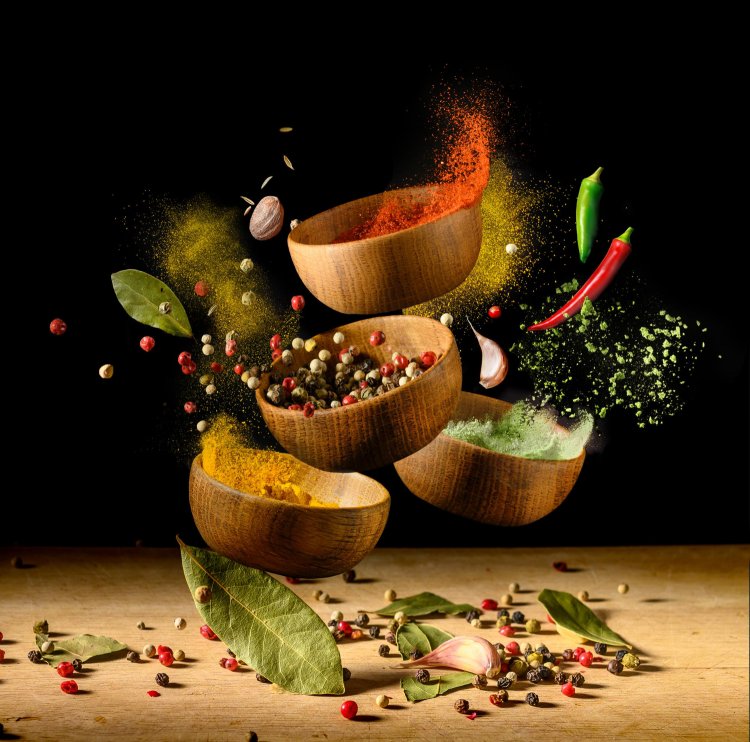Spice Wonders: From Kitchen Staples to Health Elixirs
Spices are integral to culinary traditions worldwide, celebrated not only for their ability to enhance the taste and aroma of dishes but also for their potential health benefits. Derived from various parts of plants such as seeds, bark, roots, and fruits, spices offer a diverse range of flavors and medicinal properties that have been appreciated for centuries. This comprehensive guide explores the types, culinary uses, cultural significance, health benefits, and practical tips for using spices effectively.

Types of Spices
Spices can be broadly categorized based on their botanical origin and culinary characteristics:
Seed Spices
These include cumin, coriander, mustard seeds, and fenugreek seeds, known for their earthy, nutty, or slightly bitter flavors. They are commonly used whole or ground in dishes ranging from curries to pickles.
Bark Spices
Cinnamon is the most prominent example, prized for its sweet and warm flavor profile. It is used in both sweet and savory dishes, imparting a distinctive aroma and flavor.
Root Spices
Ginger and turmeric are notable examples, celebrated for their pungent flavors and vibrant colors. Ginger is used fresh, dried, or powdered in a variety of cuisines, while turmeric adds a golden hue and earthy taste to curries and rice dishes.
Fruit Spices
Peppercorns and allspice berries fall into this category, offering varying levels of spiciness and flavor complexity. Peppercorns, in particular, are ubiquitous in global cuisines for their ability to add heat and depth to dishes.
Culinary Uses and Cultural Significance
Spices play a crucial role in culinary traditions across cultures:
Flavor Enhancement
Spices add depth, complexity, and character to dishes, transforming simple ingredients into flavorful masterpieces.
Cultural Significance
Many spices are deeply intertwined with cultural identities and culinary practices. For example, the use of cardamom in Middle Eastern coffee rituals or the incorporation of chili peppers in Mexican cuisine reflects historical traditions and regional preferences.
Global Influence
The spice trade has historically influenced global economies and cultural exchanges, shaping cuisines and culinary techniques around the world.
Health Benefits and Nutritional Value
Beyond their culinary appeal, spices offer numerous potential health benefits:
Antioxidant Properties
Spices such as cloves, cinnamon, and turmeric are rich in antioxidants, which help combat oxidative stress and inflammation in the body.
Anti-inflammatory Effects
Ginger, turmeric, and chili peppers possess anti-inflammatory properties that may aid in managing chronic inflammatory conditions.
Digestive Aid
Many spices, including ginger, cumin, and fennel seeds, are traditionally used to aid digestion, alleviate digestive discomfort, and stimulate appetite.
Metabolic Benefits
Some spices, like black pepper and ginger, have been studied for their potential to enhance metabolism and promote weight management.
Practical Tips for Using Spices
To maximize the flavor and health benefits of spices:
Storage
Store spices in airtight containers away from heat, light, and moisture to preserve their flavor and potency.
Cooking Techniques
Toasting whole spices before grinding enhances their aroma and flavor. Adding ground spices towards the end of cooking preserves their volatile oils and prevents bitterness.
Balancing Flavors
Experiment with spice combinations to achieve a balance of heat, sweetness, acidity, and umami in dishes, enhancing overall taste profiles.
Cultural and Culinary Diversity
Spices not only add flavor but also tell stories of cultural heritage and culinary innovation:
Regional Specialties
Each region of the world has its unique spice blends and usage traditions, from garam masala in India to za'atar in the Middle East and jerk seasoning in the Caribbean.
Celebratory Foods
Spices often feature prominently in celebratory and ceremonial foods, symbolizing abundance, hospitality, and cultural identity.
Future Trends and Innovations
As global interest in health-conscious eating grows, spices are gaining attention for their potential therapeutic benefits and natural flavor enhancements. Innovations in spice processing, sustainable sourcing practices, and culinary experimentation continue to shape the future of spice usage worldwide.
Spices are not merely culinary ingredients but cultural treasures with potential health-promoting properties. By incorporating a variety of spices into your diet, you can elevate the flavor and nutritional value of your meals while exploring diverse culinary traditions from around the globe. Whether used for their aromatic qualities, therapeutic effects, or cultural significance, spices continue to enrich culinary experiences and contribute to overall well-being.
#Disclaimer: The information provided in this article is for educational purposes only and should not be considered medical advice. If you have any health concerns or are experiencing symptoms, it is important to consult with a healthcare professional, such as a doctor or clinic, for proper diagnosis and treatment. Always seek the advice of your doctor or other qualified health provider with any questions you may have regarding a medical condition. Do not disregard professional medical advice or delay in seeking it because of something you have read in this article.
#Hashtags: #spices #culinary #healthbenefits #culturaldiversity #flavorenhancement #cooking #nutrition #antioxidants #digestiveaid #metabolism
What's Your Reaction?





















